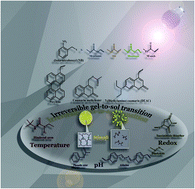Stimuli-responsive destructible polymeric hydrogels based on irreversible covalent bond dissociation
Abstract
Covalently crosslinked stimuli-destructible hydrogels with the ability of irreversible stimuli-controlled bond dissociation have attracted great attention due to their easy preparation, biocompatibility, biodegradability, stability against hydrolysis, and controlled solubility upon insertion of desired triggers. Stimuli-controlled microstructure, elasticity, and mechanical properties have resulted in their application in selective capturing, proliferation, and detection of human and bacterial cells, drug delivery, wound dressing, and imprint lithography. Polymerization approaches and different functional groups required to prepare these hydrogels with the ability of irreversible bond dissociations, mechanism of stimuli-controlled bond cleavage, degradation products, comparison between the stimulants, and their final applications are highlighted in this review. Photocleavable hydrogels containing nitrobenzyl, coumarin, and perylene derivatives, redox-dissociable hydrogels containing diselenide and succinimide thioether bonds, destructible hydrogels prepared from phenolic ester and aldazine moieties as pH-cleavable bonds, and hydrogels crosslinked by enzyme- and thermo-dissociable moieties are the most important chemically crosslinked stimuli-destructible hydrogels, which show stimuli-controlled covalent bond dissociation with an irreversible mechanism.



 Please wait while we load your content...
Please wait while we load your content...